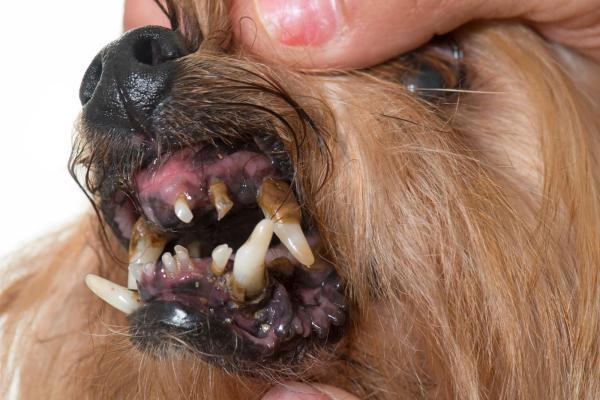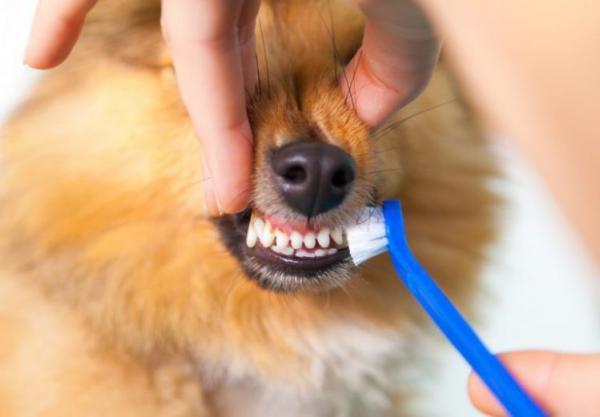
It is not only humans who are affected my dental problems. Too many dog guardians forget this, neglecting their dental hygiene until it is too late. Without proper dental care, dogs are more likely to develop one of the most common dental diseases in dogs. When we see blood on our dog's blood and teeth, we will be understandably worries. It can lead to tooth loss and other health problems. One of the most frequent causes of why your dog's gums are bleeding is due to gingivitis, a progressive inflammation of the gums.
In AnimalWised, we will tell you everything you need to know about gingivitis in dogs. We look at its symptoms, possible causes, methods of prevention and treatment. You will also find some tips to take care of your best friend's teeth, avoiding bad breath and other oral health problems.
Causes of gingivitis in dogs
Almost all oral problems in dogs start with the formation of bacterial plaque on their teeth and gums. Gingivitis is usually considered the ‘next step’ in the formation of tartar in the mouth of our dogs. This happens when we do not eliminate plaque in time. This is why it is helpful to understand the underlying causes of gingivitis in dogs and how it develops.
If your dog does not have adequate oral hygiene, including regular brushing, they will begin to accumulate food and debris between their teeth and gums. This accumulated organic matter serves to promote the growth of bacteria which are already naturally found in the mouths of dogs. With abundant food to help them grow, bacteria then reproduce rapidly. Consequently, an unhealthy amount of oral bacteria exist and plaque is formed.
Tartar is plaque which is left on the teeth long enough to mineralize. Tartar is harder to remove than plaque and helps the bacteria to multiply even further. This tartar begins to make its way over the surface of the teeth and under the gum line. This leads to inflammation, i.e. gingivitis.
When the gums are inflamed, they are more tender. They can more easily be damaged by hard pieces of food or trauma to the area. This promotes bleeding. If gingivitis has occurred and you brush their teeth, you will likely see the dog's gums bleeding due to the toothbrush moving over the sensitive area.
In the event that effective treatment is not established to combat the advance of tartar, the inflammatory process will worsen. At this point, the dog's gums can start bleeding due to normal usage of the mouth. Bacteria can then affect the muscles and bones which support the teeth, resulting in periodontitis in dogs.
Symptoms of gingitis in dogs
You may have first noticed your dog has gingivitis due to their gums bleeding. However, this will only occur after a significant amount of time has passed. The disease can progress quickly and silently without us noticing. This is why it is not only important to prevent gingivitis in dogs, but to regularly check for any changes or signs of plaque.
The first sign of canine gingivitis is usually a red strip along the gum line. This is the swelling at the point where the teeth and gums meet. As the inflammation progresses, gingival hyperplasia can occur in dogs. This is the term for excessive inflammation of the gums. Later, if gingivitis is not treated, the bleeding of the dog's gums will develop. Once this occurs, abscesses can occur which will contain a mixture of blood and pus.
Additionally, dogs with gingivitis may also exhibit the following symptoms:
- Loss of appetite and weight
- Bad breath
- Excessive salivation/drooling
- Difficulty chewing and swallowing dry feed
- Urge to constantly scratch their mouth
- Pain when the gums are touched
- Depression
- Lack of motivation to exercise
As we have mentioned, the inflammation of the gums will continue to expand into the bone and muscle tissues, leading to periodontal disease in dogs. In advanced cases of periodontitis, we can observe that the dog's teeth will decay and eventually fall out. For this reason, it is essential to fight tartar and treat gingivitis in your dog as soon as symptoms are observed.
It is important to know the difference between the dog losing teeth due to tooth decay and a puppy gaining their adult teeth. Our article on when dogs lose their baby teeth will help you learn more.

Treatment of gingivitis in dogs
When identifying any of the mentioned symptoms or any alteration in the behavior of your dog, do not hesitate to go to your veterinarian. At the clinic, the veterinary health professional will be able to evaluate the presence of tartar and gingivitis. They can request any necessary tests to observe the evolution of the bacteria in the muscular and bone structure. They can also verify the health status of your dog and evaluate for any other issues.
When the diagnosis of gingivitis is confirmed, the specific treatment will depend on the severity of the inflammation and the health status of your dog. The vet may recommend the administration of pain relievers to relieve the pain that the dog feels and improve their quality of life. NSAIDs for dogs may be used as they help to control inflammation. They may also prescribe antibiotics to fight any secondary bacterial infection.
If the bone structures have not been compromised, a surgical procedure can be performed to remove the tartar. Polish the affected teeth and help to cure gingivitis in the dog. In more serious cases, it is necessary to extract the tooth affected by gingivitis and/or periodontitis.

How to prevent gingivitis in dogs
The best way to prevent gingivitis in dogs is to provide them with a proper oral hygiene routine. This needs to be maintained throughout their life. A minimum of tooth brushing 2-3 times a week is recommended, but daily brushing is ideal. You will need to use dog-specific toothpaste and toothbrushes to perform this action. You can also make suitable DIY dog toothpaste if you cannot find any.
To know how to perform the procedure, read our article on how to clean a dog's teeth effectively. It will also be essential to check the dog's oral hygiene when you brush them. This means looking for any symptoms of gingivitis such as bleeding gums, tooth decay or even missing teeth. If you detect bad breath, tartar, swelling, abscesses or bleeding gums, do not hesitate to go to the veterinarian.
You will also need to discuss general oral hygiene with the vet during regular checkups. They may recommend your dog eat more dry food, use dental sticks to help fight tartar or advise on any specific dietary changes they may need. The use of recreational chew toys and bones can also help fight plaque in dogs as the friction of the chewing physically removes the bacterial build up. Do not use cooked bones as they can provide a choking hazard.
Brushing a dog's teeth is only one part of a dog's hygiene routine. Our video below also shows you the importance of why you need to clean your dog's ears and how to do so:

This article is purely informative. AnimalWised does not have the authority to prescribe any veterinary treatment or create a diagnosis. We invite you to take your pet to the veterinarian if they are suffering from any condition or pain.
If you want to read similar articles to My Dog's Gums Are Bleeding - Gingivitis in Dogs, we recommend you visit our Bacterial diseases category.